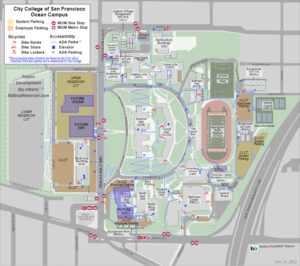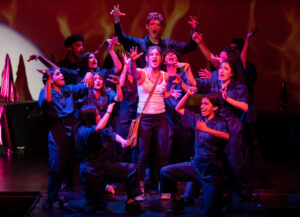In a significant stride towards fostering innovation, educational excellence and community development, City College of San Francisco (CCSF) is constructing a new Science, Technology, Engineering, Arts and Mathematics (STEAM) center. This $155 million state-of-the-art facility is being built on the college’s parking lot facing Frida Kahlo Way. The center was funded by Proposition A, an $845 million bond approved by SF voters in 2020.
The groundbreaking ceremony for the multi-story STEAM building was held the week of December 12, 2022. Featured speakers included District 7 Supervisor Myrna Melgar and CCSF college officials. Melgar is excited about the new construction. She endorsed the measure and campaigned to make sure voters were convinced the money was being allocated to a worthy cause.
The new class spaces and offerings at CCSF will provide students with hands-on learning experiences. The STEAM Complex will serve as a multidisciplinary hub for the college community. In addition to flexible social and study spaces, the new facility will include a maker space, biology, chemistry, physics and engineering labs for biotechnology, material science and circuitry and computer science labs for networking.

Designed by the Smith Group architecture firm and constructed by Rudolph and Sletten, the building will also have visual arts spaces and support spaces for the Performing Arts and Education Center. The San Francisco Building and Construction Trades Council negotiated the Project Labor Agreement (PLA) which emphasizes local hiring and quality construction jobs for building trade unions. The construction of the building itself has generated employment and given a boost to the local economy.
John Corso, a business agent with U.A. Local Union No. 38, Plumbers and Steamfitters, visited Lick-Wilmerding High School several times to meet with Allied Mechanical when LWHS was undergoing its own historic renovation and expansion, in 2019. Local 38 is one affiliate of the San Francisco Building and Construction Trades Council (SFBTC) and business manager Larry Mazzola Jr. is the current president. SFBTC is made up of 32 building and construction trade unions. According to Corso, CCSF can be credited with helping the Trades Council since, “negotiating a PLA with the building trades council, CCSF creates hundreds of union jobs, apprenticeship hours and local hires.”
“The new STEAM building is the first of an entire master plan that seeks to upgrade the facilities at San Francisco City College, so it won’t be the last,” Melgar said. “This is just the first of many other projects planned for the entire master plan, which includes a performing arts center at the corner of Frida Kahlo and Diego Streets. The new street being created will be named Diego Street. The performing arts center will host the Pan American Unity Mural at the San Francisco Museum of Modern Art (SFMOMA). That building is next after the STEAM building.” Diego Rivera’s “Pan American Unity” mural will feature special glass to protect it, making it visible from both inside and outside.
As part of CCSF’s long-term plan, the STEAM building will be the first of several buildings constructed. There is also a plan to build a $126 million Student Success Center. However, an estimated $1.2 billion upgrade is needed to improve the college’s old and unreliable facilities. The new 150,000 square feet structure has a construction budget of $175 million.
The construction of the STEAM building is a significant investment in the future of CCSF and its students. With the additional spaces, the college will be able to offer a wider range of courses, programs and certifications in science, technology, engineering, arts and mathematics. By providing a cutting-edge facility for STEAM education, the college is helping to prepare its students for the jobs of tomorrow and ensuring that San Francisco remains at the forefront of innovation and development.
Students will have the opportunity to pursue their passions and acquire in-demand skills, preparing them for careers in emerging fields such as data science, robotics, sustainable design, digital arts and more. Melgar said, “Science, math and engineering are fields that are progressing and evolving very fast right now and City College needs to have modern technology in order to train students for 21st-century careers.”
In its quest for educational excellence, innovation and community development, CCSF’s new STEAM building is poised to transform the educational landscape and empower students to thrive in the dynamic world of science, technology, engineering, arts and mathematics. As this ambitious project takes shape, CCSF’s commitment to fostering a brighter future for its students and the wider San Francisco community remains steadfast.
The construction process has been closely monitored to ensure minimal disruption to the surrounding community and adherence to strict safety protocols. While the City of San Francisco does not have approval over the project itself, they do regulate the construction at the city level. “There are all these rules about when construction trucks can come in and out of the neighborhood and if they are demolishing buildings, what noise levels are permitted. All of these things are regulated by the city like other construction projects…There will be noise and there will be some dust – that’s inevitable,” Melgar said.
Since the CCSF campus is mostly on its own, with highway 280 being its largest neighbor, “things are not going to be as disruptive as they would be downtown,” Melgar said. However, Melgar does believe there will be some slight disruption given the off-ramp from 280 to Ocean Avenue is already congested to begin with. She said, “I know that the MTA has been working with City College on a plan for how to do things differently and on the delivery hours of construction materials and heavy machinery.”
In addition to the CCSF construction that is underway, a new community is slated to be built separately from the college. The Balboa Reservoir project, right next to CCSF, will be built at the existing reservoir on a new corridor named Edwin Lee Avenue, thanks to a resolution proposed by Supervisor Melgar. According to the Balboa Reservoir website, the project is a “public-private partnership with the City of San Francisco to develop a 17-acre parcel located adjacent to CCSF.”
The new housing community will include 1100 new units, 550 affordable units, 450 market-rate rental units, 100 for-sale townhomes, four acres of public open space, 550 residential parking spaces maximum and additional public parking spaces to serve SFCC. Construction of the new neighborhood will start next year.
The $155 million STEAM Building is expected to be completed by the summer of 2024, with occupancy scheduled for 2025.







